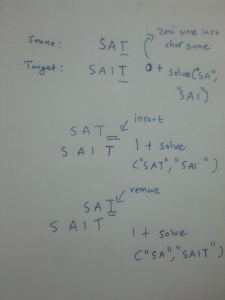A k-palindrome is a string which transforms into a palindrome on removing at most k characters.
Given a string S, and an interger K, print “YES” if S is a k-palindrome; otherwise print “NO”.
Constraints:
S has at most 20,000 characters.
0<=k<=30
Sample Test Case#1:
Input – abxa 1
Output – YES
Sample Test Case#2:
Input – abdxa 1
Output – No
Solution:
This can be solved using Edit distance dynamic programming algorithm. Edit distance DP algorithm can be used to find the minimum operations required to convert a source string to destination string. The operations can be either addition or deletion of characters.
The K-palindrome problem can be solved using Edit distance algorithm by checking if the minimum operation required to convert the input string to its reverse.
Let editDistance(source,destination) be the function which takes source string and destination string and returns the minimum operations required to convert the source string to destination string.
A string S is K-palindrome if editDistance(S,reverse(S))<=2*K
This is because we can transform the given string S into its reverse by deleting K letters and then inserting K letters.
This will be more clear with an example.
Let S=madtam and K=1.
To convert it into reverse of S, i.e matdam first we have to remove the character at index 3 ( 0 based index) in S.
Now the intermediate string is madam . Then we have to insert the character t at index 2 in the intermediate string to get “matdam” which is the reverse of string s.
If you look carefully you will know that the intermediate string “madam” is the palindrome that is obtained by removing k=1 characters.
